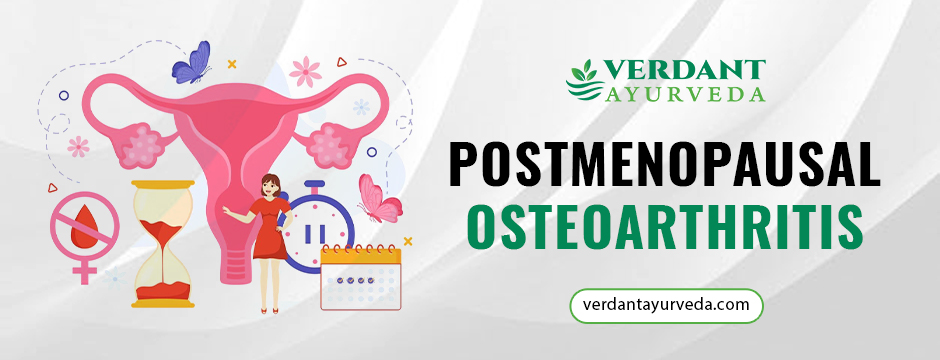Postmenopausal osteoarthritis is an increasing problem for the majority of women. As hormone levels decrease post-menopause, joint pain and stiffness are a part of everyday life. Even everyday things like walking, bending, or even gripping something turn into problems. But does Ayurveda work? The answer is yes. Panchakarma, a proven Ayurvedic detox treatment, can really give relief.
Let’s see how.
Understanding Postmenopausal Osteoarthritis
Osteoarthritis is a disease where the cartilage in the joint wears off. This leads to pain, swelling, and reduced movement. In postmenopausal women, this is more common as estrogen levels drop. Estrogen, in addition to being essential for fertility, is also essential for joints and bones. Once the hormone decreases after menopause, joints are more likely to suffer from wear and tear.
Symptoms:
- Joint stiffness, especially in the mornings
- Pain in the hips, knees, hands, or back
- Swelling of joints
- Restricted mobility
- Grinding or creaking sound in joints
Present medicine tends to treat this with medication or surgery. But Ayurveda gives a natural, mild, and long-lasting solution.
What Is Panchakarma?
Panchakarma literally means “five actions” in Sanskrit. Panchakarma is a deep cleansing treatment used in Ayurveda to remove toxins (ama) from the body. Panchakarma balances the three doshas—Vata, Pitta, and Kapha—assumed to regulate the body’s functions.
The five main therapies are:
- Vamana – Therapeutic vomiting to rid the upper half of the body of toxins.
- Virechana – Purging therapy to cleanse the bowels.
- Basti – Medicated enemas to clean and nourish the colon.
- Nasya – Ingestion of medicated oil through the nose.
- Raktamokshana – Bloodletting (not normally utilised today and in the hands of experts).
For osteoarthritis, especially osteoarthritis of postmenopausal women, Basti and Virechana are usually prescribed.
Why Panchakarma is Beneficial in Osteoarthritis
Osteoarthritis, as per Ayurveda, is essentially caused by an imbalance of aggravated Vata dosha. Vata controls movement, dryness, and nerve function. During postmenopause, Vata naturally increases in the body, leading to dry joints, pain, and stiffness.
Panchakarma helps by:
- Removing deeply rooted toxins that get stored in joints
- Hydrating joints and increasing flexibility
- Balancing Vata dosha
- Reducing inflammation naturally
- Supporting tissues (dhatus), especially bones and joints
Key Panchakarma Therapies for Postmenopausal Osteoarthritis
1. Snehan (Oil Massage)
Before Panchakarma, the body is predisposed with Snehan—external and internal oiling. Herbal oils are used for body massage. The oils seep deep within and loosen the frozen joints. Ghee (clarified butter) may be given internally to precondition the digestive system for cleansing.
2. Swedana (Herbal Steam Therapy)
After the oil massage, herbal steam is applied. This helps open the body’s channels and reduces joint stiffness. It also helps oils go deeper into the tissues.
3. Basti (Medicated Enema)
This is one of the best treatments for Vata disorders like osteoarthritis. Decoction or special oil is given through the rectum. It is a strange but gentle and very effective treatment. Basti reduces dryness of joints, cleanses the colon, and strengthens bones.
There are two types of Basti:
- Anuvasana Basti – Oil-based enema to lubricate and nourish
- Niruha Basti – Decoction-based enema to remove toxins
Both are usually given alternately for 8 to 30 days, depending on the severity of the condition.
4. Virechana (Purgation)
If the body is also showing symptoms of Pitta imbalance (like swelling, burning, or redness in joints), Virechana is given. It purifies the liver and intestines. The treatment reduces inflammation and enhances digestion. This is highly important in Ayurveda to cure any disease.
Ayurvedic Herbs Supporting Panchakarma
Besides Panchakarma, certain herbs are also used to promote healing:
- Shallaki (Boswellia serrata) – Reduces joint pain and inflammation
- Ashwagandha – Strengthens bones and muscles
- Guggulu – Anti-inflammatory in nature
- Triphala – Cleanses the digestive system and helps in detoxification
- Dashmool – Blend of 10 roots that calms Vata and cures pain
These herbs may be taken in powder, tablet, or decoction form, based on your doctor’s advice.
Diet and Lifestyle Tips Post-Panchakarma
Panchakarma is not a treatment but rather a reboot. Once the therapies are finished, it is essential to maintain the outcome.
Dietary Advice:
- Consume warm, cooked food
- Make use of spices such as turmeric, ginger, and cumin
- Do not consume cold, raw, and dry foods
- Consume warm water or herbal teas
- Eat ghee and healthy oils for lubrication
Lifestyle Advice:
- Have a regular sleep routine
- Perform gentle yoga or walking
- Maintain warm joints
- Avoid prolonged sitting and excessive exertion
- Get routine Abhyanga (oil massage)
What to Expect from Panchakarma
Panchakarma is not a one-day solution. It is a deep and gradual healing process. For many women dealing with menopause joint pain, relief often begins within the first few sessions. Pain becomes less intense, stiffness in the joints reduces, and overall energy improves. Over time, many women also notice better sleep, smoother digestion, and a sense of inner balance.
However, the results depend on your age, the severity of osteoarthritis, and how well you follow the aftercare routine.
Always consult with a trusted Ayurvedic physician before starting Panchakarma. It must be personalized based on your body type (Prakriti), age, strength, and stage of menopause.
Final Thoughts

Postmenopausal osteoarthritis doesn’t have to degrade your quality of life. Ayurveda has a safe, natural, and effective way to experience relief. Under the guidance of experts, Panchakarma can detoxify your body, alleviate pain, and restore movement and happiness.
At Verdant Ayurveda, we believe every woman’s journey through menopause deserves a personalised and compassionate approach. While therapies like Panchakarma require in-person care, the principles behind them—such as detoxification, balancing the doshas, and nourishing the joints—can inspire effective lifestyle and herbal strategies. Through guided Ayurvedic support, women can manage menopause-related joint pain and work toward a more balanced, pain-free life in a natural way.
